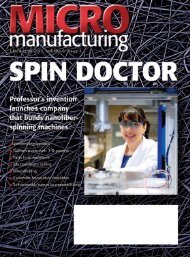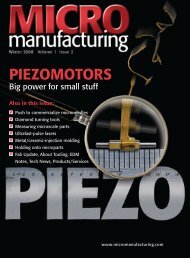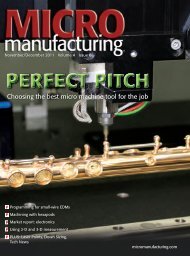to view as PDF - MICROmanufacturing
to view as PDF - MICROmanufacturing
to view as PDF - MICROmanufacturing
You also want an ePaper? Increase the reach of your titles
YUMPU automatically turns print PDFs into web optimized ePapers that Google loves.
TECHnews<br />
these technologies creates new design<br />
options—allowing the engineer <strong>to</strong> create<br />
smaller, thinner, lighter and morefunctional<br />
end products.”<br />
Vartanian added that most approach-<br />
In brief…<br />
Every day brings news of exciting micromanufacturingrelated<br />
research underway at the nation’s universities. Below<br />
is a sampling of five ongoing research projects. Additional<br />
information about each can be found on our Web<br />
site, www.micromanufacturing.com.<br />
L<strong>as</strong>er/lathe combo takes on brittle materials. Researchers<br />
at Western Michigan University have built a hybrid<br />
machine that reportedly cuts brittle, difficult-<strong>to</strong>-machine<br />
materials—like gl<strong>as</strong>s, ceramics and porcelain—in a highly<br />
efficient manner. The machine combines single-point-diamond<br />
turning and l<strong>as</strong>ing. In operation, the beam of a nearinfrared<br />
fiber l<strong>as</strong>er p<strong>as</strong>ses through an optically transparent<br />
diamond cutting <strong>to</strong>ol and emerges at a point on the workpiece<br />
just in front of the <strong>to</strong>ol’s cutting edge. The l<strong>as</strong>er softens<br />
the workpiece material before the <strong>to</strong>ol cuts it, which eliminates<br />
fracturing of brittle parts and lowers <strong>to</strong>ol wear.<br />
L<strong>as</strong>er beam<br />
Pl<strong>as</strong>tic deformation/<br />
chip formation<br />
High-pressure-ph<strong>as</strong>etransformation<br />
region<br />
Depth<br />
of cut<br />
Load<br />
-45° rake angle Single crystal diamond <strong>to</strong>ol<br />
Western Michigan University<br />
With WMU’s µLAM machine, a l<strong>as</strong>er beam is directed through a<br />
diamond cutting <strong>to</strong>ol, ahead of the cutting edge.<br />
Memory chip can take the heat. Rice University researchers<br />
have developed transparent memory chips that are<br />
flexible enough <strong>to</strong> be folded in half and can survive hostile<br />
conditions, including 1,000° F temperatures. Speaking at<br />
the 243rd National Meeting & Exposition of the American<br />
Chemical Society, Rice chemist James M. Tour said devices<br />
that incorporate the chips can retain data despite an accidental<br />
trip through a clothes dryer—or even a voyage <strong>to</strong><br />
Mars. And, with their unique 3-D internal architecture, the<br />
new chips can s<strong>to</strong>re extra gigabytes of data while consuming<br />
less space.<br />
Short circuiting implantable-device hackers. Researchers<br />
10 | MAY/JUNE 2012 | <strong>MICROmanufacturing</strong><br />
Cutting direction<br />
Cutting edge radius<br />
Machined surface<br />
Ceramic workpiece<br />
es used <strong>to</strong> print electronics are b<strong>as</strong>ed on<br />
traditional 2-D printing methods, such<br />
<strong>as</strong> inkjet and screen printing. These<br />
methods don’t work for printing electronics<br />
that must conform <strong>to</strong> the shape<br />
at Purdue and Prince<strong>to</strong>n universities have produced a pro<strong>to</strong>type<br />
device that works <strong>as</strong> a firewall <strong>to</strong> block hackers from<br />
interfering with implantable, wireless medical devices, such<br />
<strong>as</strong> pacemakers, insulin-delivery systems and brain implants,<br />
according <strong>to</strong> a Purdue press rele<strong>as</strong>e. Operationally, the device<br />
relies on “multilayered anomaly detection” technology<br />
<strong>to</strong> identify potentially<br />
malicious transactions.<br />
When detected,<br />
the firewall alerts the<br />
patient or blocks “malicious<br />
packets” from<br />
reaching the medical<br />
device via electronic-<br />
jamming technology.<br />
The Purdue-Prince<strong>to</strong>n<br />
pro<strong>to</strong>type, dubbed<br />
MedMon (short for<br />
of 3-D structures.<br />
The joint venture’s first project is<br />
the development of a “smart wing”<br />
for an unmanned aerial vehicle<br />
(UAV) model. The wing incorporates<br />
Bos<strong>to</strong>n University<br />
Bos<strong>to</strong>n University researchers<br />
developed this microfluidic device for<br />
diagnosing the flu.<br />
medical moni<strong>to</strong>r), can be worn like a necklace or installed<br />
in a cell phone.<br />
Self-<strong>as</strong>sembly with ‘smart sand.’ Scientists at M<strong>as</strong>sachusetts<br />
Institute of Technology’s Distributed Robotics Labora<strong>to</strong>ry<br />
have developed algorithms that would enable heaps<br />
of smart sand <strong>to</strong> <strong>as</strong>sume any shape, allowing spontaneous<br />
formation of new <strong>to</strong>ols or duplication of broken mechanical<br />
parts. Unlike many other approaches <strong>to</strong> self-<strong>as</strong>sembly,<br />
smart sand follows a subtractive method, akin <strong>to</strong> s<strong>to</strong>ne<br />
carving, rather than an additive method, such <strong>as</strong> snapping<br />
LEGO blocks <strong>to</strong>gether. With smart sand, individual grains<br />
p<strong>as</strong>s messages back and forth and selectively attach <strong>to</strong> each<br />
other <strong>to</strong> form a 3-D object.<br />
Point-of-care device diagnoses flu. Researchers in the Biomedical<br />
Engineering Department at Bos<strong>to</strong>n University have<br />
published results of a 4-year study that reportedly validates<br />
the pro<strong>to</strong>type of a rapid, low-cost, point-of-care microfluidic<br />
device capable of quickly diagnosing the flu. “The researchers<br />
miniaturized an expensive 3-hour, lab-scale diagnostic<br />
test—known <strong>as</strong> RT-PCR and [currently] considered<br />
the gold standard in flu detection—in<strong>to</strong> a single-use microfluidic<br />
chip,” according <strong>to</strong> a report posted on the BU Web<br />
site. About the size of a microscope slide, the chip consists<br />
of a column at the <strong>to</strong>p that extracts ribonucleic acid (RNA)<br />
from a sample <strong>as</strong>sociated with a flu virus, a middle chamber<br />
that converts the RNA in<strong>to</strong> deoxyribonucleic acid (DNA)<br />
and a channel at the bot<strong>to</strong>m that replicates enough of the<br />
DNA <strong>to</strong> allow it <strong>to</strong> be read by an external device.















